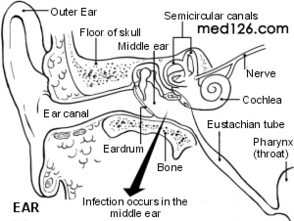Understanding Ear Infection: A Comprehensive Guide for You
Ear infections, also known as otitis, are a common health issue affecting people of all ages. Whether you’re a child, an adult, or an elderly individual, understanding the intricacies of ear infections can help you manage them effectively. In this article, we will delve into the various aspects of ear infections, including their causes, symptoms, diagnosis, treatment, and prevention. Let’s embark on this journey to unravel the mysteries of ear infections.
Causes of Ear Infections

Ear infections can be caused by various factors, but the most common ones include:
| Causes | Description |
|---|---|
| Bacteria | Bacterial infections are often caused by Streptococcus pneumoniae and Haemophilus influenzae. |
| Viruses | Viruses like the common cold and flu can lead to ear infections. |
| Fluid Build-up | Fluid accumulation in the middle ear can lead to infections. |
| Foreign Objects | Inserting foreign objects into the ear canal can cause infections. |
| Immunodeficiency | Individuals with weakened immune systems are more susceptible to ear infections. |
Types of Ear Infections

Ear infections can be categorized into three types based on their location:
- Outer Ear Infection (Otitis Externa): This type of infection affects the outer ear canal, often caused by bacteria or fungi.
- Middle Ear Infection (Otitis Media): This is the most common type of ear infection, affecting the middle ear space behind the eardrum. It can be acute, chronic, or recurrent.
- Inner Ear Infection (Otitis Interna): This type of infection affects the inner ear, which includes the cochlea and vestibular system. It is less common and can be severe.
Symptoms of Ear Infections

Ear infections can present various symptoms, depending on the type and severity. Common symptoms include:
- Pain or Discomfort in the Ear: This is often the first sign of an ear infection.
- Redness or Swelling of the Ear: You may notice redness or swelling around the ear.
- Discharge from the Ear: A yellow, green, or bloody discharge may come from the ear.
- Feeling of Fullness in the Ear: You may feel pressure or fullness in the ear.
- Hearing Loss: Temporary or permanent hearing loss can occur.
- Dizziness or Vertigo: Inner ear infections can cause dizziness or vertigo.
- Loss of Balance: Inner ear infections can also lead to a loss of balance.
Diagnosis of Ear Infections
Diagnosing ear infections typically involves a physical examination and medical history. The healthcare provider may use the following methods:
- Visual Examination: The healthcare provider will examine the ear canal and eardrum using an otoscope.
- Fluid Detection: A tympanogram can detect fluid in the middle ear.
- Swabbing: A swab may be taken to test for bacteria or fungi.
Treatment of Ear Infections
The treatment of ear infections depends on the type, severity, and underlying cause. Common treatment options include:
- Antibiotics: Bacterial infections are often treated with antibiotics. However, it’s essential to complete the full course of medication, even if symptoms improve.
- Pain Relief: Over-the-counter pain relievers like acetaminophen or ibuprofen can help alleviate pain and discomfort.


